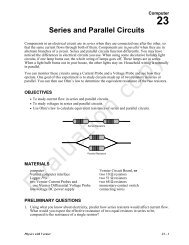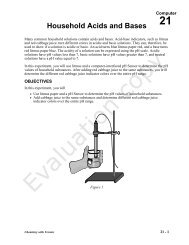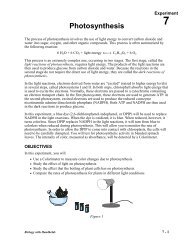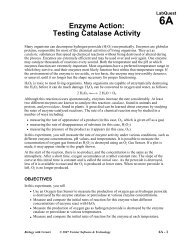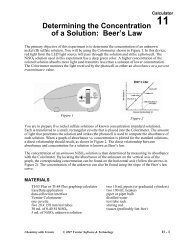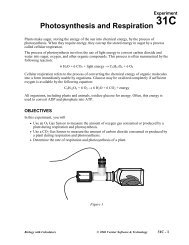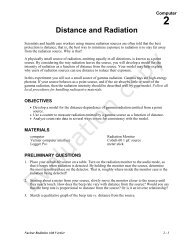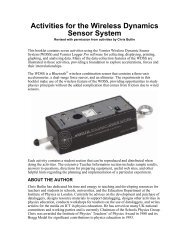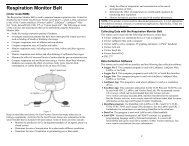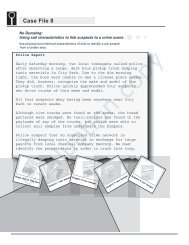Picket Fence Free Fall - Vernier Software & Technology
Picket Fence Free Fall - Vernier Software & Technology
Picket Fence Free Fall - Vernier Software & Technology
Create successful ePaper yourself
Turn your PDF publications into a flip-book with our unique Google optimized e-Paper software.
<strong>Picket</strong> <strong>Fence</strong> <strong>Free</strong> <strong>Fall</strong>LabQuest5We say an object is in free fall when the only force acting on it is the earth’s gravitational force.No other forces can be acting; in particular, air resistance must be either absent or so small as tobe ignored. When the object in free fall is near the surface of the earth, the gravitational force onit is nearly constant. As a result, an object in free fall accelerates downward at a constant rate.This acceleration is usually represented with the symbol, g.Physics students measure the acceleration due to gravity using a wide variety of timing methods.In this experiment, you will have the advantage of using a very precise timer connected to theLabQuest and a Photogate. The Photogate has a beam of infrared light that travels from one sideto the other. It can detect whenever this beam is blocked. You will drop a piece of clear plasticwith evenly spaced black bars on it, called a <strong>Picket</strong> <strong>Fence</strong>. As the <strong>Picket</strong> <strong>Fence</strong> passes throughthe Photogate, the LabPro interface will measure the time from the leading edge of one barblocking the beam until the leading edge of the next bar blocks the beam. This timing continuesas all eight bars pass through the Photogate. From these measured times, the program willcalculate the velocities and accelerations for this motion and graphs will be plotted.<strong>Picket</strong>fenceOBJECTIVEFigure 1• Measure the acceleration of a freely falling body (g) to better than 0.5% precision using a<strong>Picket</strong> <strong>Fence</strong> and a Photogate.MATERIALSLabQuestLabQuest App<strong>Vernier</strong> Photogate<strong>Picket</strong> <strong>Fence</strong>clamp or ring stand to secure PhotogatePhysics with <strong>Vernier</strong> © 2007 <strong>Vernier</strong> <strong>Software</strong> & <strong>Technology</strong> 5 - 1
LabQuest 5PRELIMINARY QUESTIONS1. Inspect your <strong>Picket</strong> <strong>Fence</strong>. You will be dropping it through a Photogate to measure g. Thedistance, measured from one edge of a black band to the same edge of the next band, is5.0 cm. What additional information will you need to determine the average speed of the<strong>Picket</strong> <strong>Fence</strong> as it moves through the Photogate?2. If an object is moving with constant acceleration, what is the shape of its velocity vs. timegraph?3. Does the initial velocity of an object have anything to do with its acceleration? For example,compared to dropping an object, if you throw it downward would the acceleration bedifferent after you released it?PROCEDURE1. Fasten the Photogate rigidly to a ring stand so the arms extend horizontally, as shown inFigure 1. The entire length of the <strong>Picket</strong> <strong>Fence</strong> must be able to fall freely through thePhotogate. To avoid damaging the <strong>Picket</strong> <strong>Fence</strong>, make sure it has a soft landing surface.2. Connect the Photogate to DIG 1 of LabQuest and choose New from the File menu. If youhave an older sensor that does not auto-ID, manually set up the sensor.3. Now collect your free fall data. To do this, start data collection and wait for a moment.4. Hold the top of the <strong>Picket</strong> <strong>Fence</strong> and drop it through the Photogate, releasing it from yourgrasp completely before it enters the Photogate. Be careful when releasing the <strong>Picket</strong> <strong>Fence</strong>.It must not touch the sides of the Photogate as it falls and it needs to remain vertical.5. When the <strong>Picket</strong> <strong>Fence</strong> has completely passed through the Photogate, a graph of distance vs.time and velocity vs. time will appear on the screen. Sketch the graphs on paper for later use.6. Examine your velocity vs. time graph. The slope of a velocity vs. time graph is a measure ofacceleration. If the velocity graph is approximately a straight line of constant slope, theacceleration is constant. If the acceleration of your <strong>Picket</strong> <strong>Fence</strong> appears constant, fit astraight line to your data.a. Choose Curve Fit from the Analyze menu.b. Select Linear as the Fit Equation.c. Record the slope of the linear curve fit in the data table.d. Select OK.7. To establish the reliability of your slope measurement, repeat Steps 3–6 five more times. Donot use drops in which the <strong>Picket</strong> <strong>Fence</strong> hits or misses the Photogate. Record the slope valuesin the data table.5 - 2 Physics with <strong>Vernier</strong>
<strong>Picket</strong> <strong>Fence</strong> <strong>Free</strong> <strong>Fall</strong>DATA TABLETrial 1 2 3 4 5 6Slope (m/s 2 )Acceleration (m/s 2 )Minimum Maximum AverageAcceleration due to gravity, g ± m/s 2Precision %ANALYSIS1. From your six trials, determine the minimum, maximum, and average values for theacceleration of the <strong>Picket</strong> <strong>Fence</strong>. Record them in the data table.2. Describe in words the shape of the distance vs. time graph for the free fall of the picket fence.3. Describe in words the shape of the velocity vs. time graph. How is this related to the shape ofthe distance vs. time graph?4. The average acceleration you determined represents a single best value, derived from all yourmeasurements. The minimum and maximum values give an indication of how much themeasurements can vary from trial to trial; that is, they indicate the precision of yourmeasurement. One way of stating the precision is to take half of the difference between theminimum and maximum values and use the result as the uncertainty of the measurement.Express your final experimental result as the average value, ± the uncertainty. Round theuncertainty to just one digit and round the average value to the same decimal place.For example, if your minimum, average, and maximum values are 9.12, 9.93, and 10.84 m/s 2 ,express your result as g = 9.9 ± 0.9 m/s 2 . Record your values in the data table.5. Express the uncertainty as a percentage of the acceleration. This is the precision of yourexperiment. Enter the value in your data table. Using the example numbers from the last step,the precision would be0.99.9× 100% =6. Compare your measurement to the generally accepted value of g (from a textbook or othersource). Does the accepted value fall within the range of your values? If so, your experimentagrees with the accepted value.7. Inspect your velocity graph. How would the associated acceleration vs. time graph look?Sketch your prediction on paper. Change the y-axis to acceleration. Comment on anydifferences between the acceleration graph and your prediction. To examine the data pairs onthe displayed graph, tap any data point. As you tap each data point, the acceleration and timevalues are displayed to the right of the graph. Note that the vertical scale of the graph doesnot include zero. Is the variation as large as it appears?9 0 0Physics with <strong>Vernier</strong> 5 - 3
LabQuest 58. Find the average acceleration by examining the values displayed to the right of the graph.How does this compare with the acceleration value for the same drop, determined from theslope of the velocity graph?EXTENSIONS1. Use the distance vs. time data and a quadratic fit to determine g.2. Display the acceleration vs. time graph and note the apparent variation in acceleration.Examine the data pairs on the displayed graph, by selecting any data point. Read theacceleration values individually. Is the acceleration varying as much as it first appears?3. Would dropping the <strong>Picket</strong> <strong>Fence</strong> from higher above the Photogate change any of theparameters you measured? Try it.4. Would throwing the <strong>Picket</strong> <strong>Fence</strong> downward, but letting go before it enters the Photogate,change any of your measurements? How about throwing the <strong>Picket</strong> <strong>Fence</strong> upward? Tryperforming these experiments.5. How would adding air resistance change the results? Try adding a loop of clear tape to theupper end of the <strong>Picket</strong> <strong>Fence</strong>. Drop the modified <strong>Picket</strong> <strong>Fence</strong> through the Photogate andcompare the results with your original free fall results.6. Investigate how the value of g varies around the world. For example, how does altitude affectthe value of g? What other factors cause this acceleration to vary at different locations? Howmuch can g vary at a location in the mountains compared to a location at sea level?5 - 4 Physics with <strong>Vernier</strong>
ExperimentTEACHER INFORMATION 5<strong>Picket</strong> <strong>Fence</strong> <strong>Free</strong> <strong>Fall</strong>1. The student pages with complete instructions for data collection using LabQuest App,Logger Pro (computers), EasyData or DataMate (calculators), and DataPro (Palm handhelds)can be found on the CD that accompanies this book. See Appendix A for more information.2. Dirty or scratched <strong>Picket</strong> <strong>Fence</strong>s may give erratic results.3. <strong>Picket</strong> <strong>Fence</strong>s are available from <strong>Vernier</strong> <strong>Software</strong> (order code PF). You can make your own<strong>Picket</strong> <strong>Fence</strong>s using clear plastic and black tape, but the tape tends to stretch as it is placed onthe plastic. It is difficult to achieve precise results with a handmade fence. To use thesupplied experiment file, the leading edge separation of the bars must be 5.00 cm.4. It is important that the <strong>Picket</strong> <strong>Fence</strong> remain vertical during the fall. If not, the verticaldistance between bars gets smaller and the results are off.5. The Photogate must be rigidly fixed to avoid noise or systematic errors. In particular, do nothold the Photogate in your hand.6. You may want to have the students drop the <strong>Picket</strong> <strong>Fence</strong> onto a rug so that it does not getscratched or damaged.7. There is a good discussion of variation in the acceleration due to gravity on the earth's surfacein the chapter on gravitation in Fundamentals of Physics by Halliday, Resnick, and Walker.8. Another alternative to the extension in which students put a piece of tape on the end of the<strong>Picket</strong> <strong>Fence</strong> to add air resistance is to tape a coffee filter, parachute style, to the top of thepicket fence and proceed as instructed.Physics with <strong>Vernier</strong>5 - 1 T
Experiment 5SAMPLE RESULTSTrial 1 2 3 4 5 6Slope (m/s 2 ) xxxx xxxx xxxx xxxx xxxx xxxxMinimum Maximum AverageAcceleration (m/s 2 ) xxxx xxxx xxxxAcceleration due to gravity, gPrecisionxxxxxxxxANSWERS TO PRELIMINARY QUESTIONSANSWERS TO ANALYSIS QUESTIONSAnswers have been removed from the online versions of <strong>Vernier</strong>curriculum material in order to prevent inappropriate student use.Graphs and data tables have also been obscured. Full answers andsample data are available in the print versions of these labs.5 - 2 T Physics with <strong>Vernier</strong>




